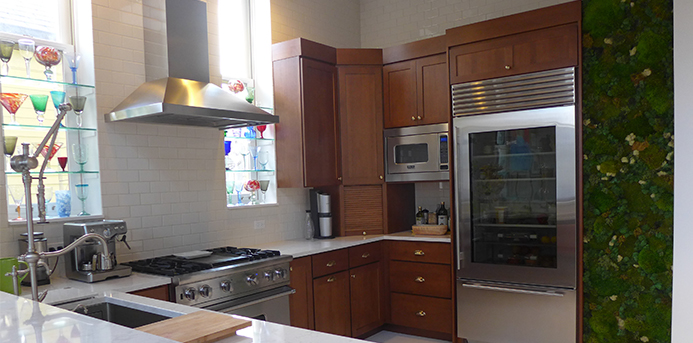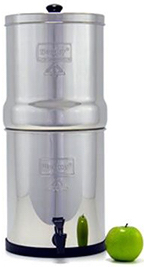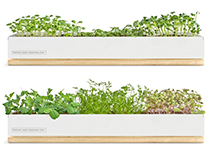The kitchen? We’re fans – that’s where the food is, after all. But it’s also the heart of the home, a warm and welcoming place to gather. So why not make your kitchen as friendly to the environment as it is to your family and friends? Whether you’re renovating or just greening the lily, so to speak, these eco-savvy ideas for a greener kitchen are something to chew on.
Want more eco-friendly tips for your home? Check out these articles:
Conserve Resources
 The kitchen may be the heart of the home, but it may also be your biggest energy suck. Jam-packed with appliances and fixtures—like your refrigerator, which runs 24 hours a day, 365 days a year (ahem)—the kitchen is begging for some energy efficiency. Karen Kalmek, founder of Green Home Chicago, a design center specializing in eco-friendly and sustainable interior design, recommends Energy Star appliances and conserving water with a low-flow faucet. Make the most of natural light with skylights and large windows, and swap incandescent bulbs for LEDs.
The kitchen may be the heart of the home, but it may also be your biggest energy suck. Jam-packed with appliances and fixtures—like your refrigerator, which runs 24 hours a day, 365 days a year (ahem)—the kitchen is begging for some energy efficiency. Karen Kalmek, founder of Green Home Chicago, a design center specializing in eco-friendly and sustainable interior design, recommends Energy Star appliances and conserving water with a low-flow faucet. Make the most of natural light with skylights and large windows, and swap incandescent bulbs for LEDs.
“We need to think more holistically about water and our natural resources in general,” Kalmek says.
Consider Cabinets

Cabinetry takes up the most valuable real estate in your kitchen and sets the aesthetic tone for the entire space—so choose wisely. Look for cabinets made of sustainable materials like FSC certified lumber or bamboo, and avoid products that contain potentially harmful agents like urea formaldehyde. Buying from a local manufacturer is another great way to be green. “When we support local manufacturers and businesses, we reduce the carbon footprint of shipping things across the country (or world), and support local communities and families,” Kalmek says.
 Reduce Waste
Reduce Waste
Composting and recycling significantly cut down on your kitchen waste, which means less trash in the landfill, less methane production and fewer plastic garbage bags. Make recycling a no-brainer with a well-designed receptacle that keeps your trash and recycling bin in the same sleek container. And don’t let composting intimidate you—all you need is a container for scraps and a compost bin. And, if you’re thinking, “Ew, worms,” then have no fear—there are plenty of composting systems for the urban and/or squeamish. The Sun-Mar Garden Composter is completely worm-free. Just dump your scraps and spin the drum. Done. Now, don’t you feel better?
Filter Water
Kick your plastic water bottle addiction and eliminate contaminants from your tap water with a carbon filtration system. Carbon filters are great for removing chemicals like VOCs, herbicides and pesticides as well as bacteria and parasites. They come in a variety of models ranging from simple countertop units to whole-house systems that filter water from every faucet.
Clean Green
Now that you’ve got a gorgeous green kitchen, keep it sparkling and toxin-free! Cleaning products made with naturally derived and plant-based ingredients and non-synthetic fragrances won’t pollute waterways and air quality in the service of spick-and-span floors. Recycled or refillable packaging is an extra eco-bonus.
Get Growing
“Plants give off oxygen which improve air quality and are known to improve mood,” Kalmek says. A micro-green garden on a window sill, like this elegant kit from Uncommon Goods, will do the trick while keeping fresh, pesticide-free herbs and spices at hand. Or, make a dramatic statement with a wall of greenery. “There are now easy to maintain living walls that require filling a storage unit once every two weeks,” Kalmek says.
Put Countertops to Work
A hard-wearing material like engineered quartz is a great countertop option for the green-minded. “When we purchase quality that lasts, we do not have to replace items so frequently,” Kalmek says. Quartz is also a non-porous material, so unlike granite or marble, it doesn’t require any protective chemical sealants.
Renovate With Recycled or Salvaged Materials
“Construction debris is one of the major contributors to land fills,” says Kalmek. Rescue discarded materials headed for the dump by choosing products made with recycled content. “We offer countertops and tiles that are…part of what is called a Waste to Profit Network, where the waste of one industry is used in the manufacture of another product,” Kalmek says. Salvage shops like Rebuilding Exchange are also great place to unearth hidden gems. A gorgeous 19th century barn floor would add rustic patina and tons of charm to a 21st century kitchen.
Invest in Classic Cookware
Why mess around with non-stick coatings—which release toxic gases when overheated—when the same cast iron skillet your grandmother used is naturally non-stick and non-toxic? Cast iron, enameled cast iron and stainless steel all wear like, well, iron—so you’ll likely never have to replace these pieces. Plus, you’ll look pro with a pot rack full of shimmering Le Creuset.




